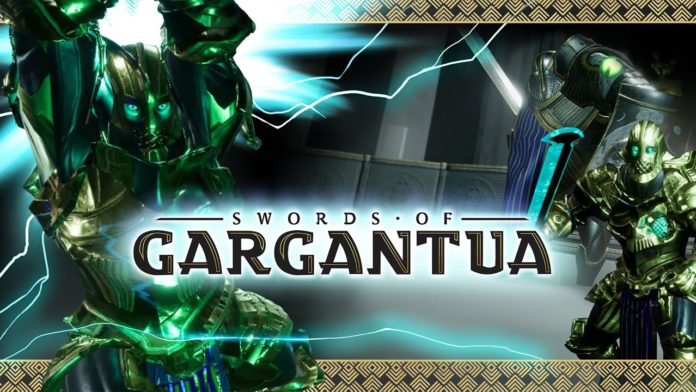Headsets: SteamVR, Oculus Rift, Oculus Quest (reviewed) MSRP: $20
Is your fancy teased by the idea of battling it out against 10-foot tall giants? Enter Swords of Gargantua, the second entry into VR by Japanese developer Yomuneco Inc. The base concept of Swords of Gargantua is that it’s a wave slasher with a focus on fleshed out melee combat mechanics and a tidy variety of enemies. While it won’t make such a big impact on PCVR players who’ve had their hands on GORN and Blade & Sorcery for some time now, Swords of Gargantua offers fully physics-based combat, crossplay co-op with up to three other players in addition to yourself, and standalone Oculus Quest support.
Preparation
Prepare for Swords of Gargantua the way you’d prepare for other games that offer a sizeable workout. Drink plenty of water and keep some extra water near you, for when you finish. Stay fed with good foods, et al.
Intensity – 7/10
Swords of Gargantua is decidedly a relaxed, or LISS (low-intensity steady state) kind of game. At least, this assessment will apply for anybody who often plays intense games such as Beat Saber or BOXVR, or is regularly athletic outside of VR. According to my Apple Watch S2, I burned 205 calories total (152 active calories) in 32 minutes with Swords of Gargantua. Take note that the physical gameplay is a bit like Blade & Sorcery, but slower and more methodical.
Arms – 7/10
Your arms will get quite a workout as you swing them around to simulate fighting big enemies with swords, maces, and around 28 other varieties of melee weapons. Combat is slower-paced and generally more telegraphed in Swords of Gargantua than in other arena combat games, so there’s less pressure to swing more frequently. You are more inclined to hold back and wait for the right moment to swing for the most impact, which categorically means the game is less intense.
Legs – 5/10
At least on the Quest version of Swords of Gargantua, you’ll want to continue scanning all 360 degrees of your peripheral vision in case an enemy flanks you. As you move around in the real world to cover all potential ambush points, your legs will soak up some movement.
Core and Balance – 7/10
The dodge roll mechanic of Swords of Gargantua is based on holding both triggers and leaning in the direction you’d like to move. You can perform a dodge roll both to get closer to and further from danger, but you really have to lean into the roll each time. When things get tense in the arena, the dodge roll mechanic starts to feel a little bit like virtual surfing, and you need to stay balanced in order to pull off continuous rolls.
Time Perception – 8/10
Swords of Gargantua is enjoyable, it has fun mechanics, and you probably won’t notice that you’re burning many or any calories at all.
Replayability – 10/10
The entire game is a series of replayable missions and arena scenarios that pit you against waves of enemies. It’d be very difficult to call this anything other than infinitely replayable. Is that time well spent, however? Really, that’s up to how much fun you’re having and how much of a workout you want to achieve while playing a VR arena game.
Fitness Scalability – 8/10
If you can add weights and run in place while playing a game, you can scale it. Seeing as how you can do both in Swords of Gargantua, it deserves a high ‘Fitness Scalability’ score. That said, it isn’t perfect. The ‘curve’ isn’t as smooth here as it is in a game like Beat Saber, where the gameplay is consistently intense regardless of difficulty mode.
Lack of Nausea – 7/10
I don’t get nausea, but the simple fact that the game includes smooth motion knocks a few points off of this score. We haven’t really gotten to a point where people are entirely skipping motion sickness with smooth motion in VR, even though it’s something a lot of exploration-focused games need. The only awkward part of this is that there is positively no exploration happening here at all whatsoever. You’re only navigating around an arena that disappears or resets when all the enemies are dead.
Social Competition – 5/10
Swords of Gargantua isn’t a competitive game. I guess you could have community competitions regarding who kills the most enemies in the arena, but that’s not as compelling as a direct PVP mode.
VRFI Fit Score – 7
The Good
Swords of Gargantua offers some interesting arena combat and introduces the Oculus Quest to a fully-realized weapons physics system and a co-op mode to accompany it. From a workout perspective, playing Swords of Gargantua will burn you a rough estimate of 200 calories in ~30 minutes without much effort.
The Bad
It promises to be an “RPG”, but it’s simply an arena wave slasher with well-built combat mechanics. And there’s really nothing much to it beyond that. The challenges are all very much the same thing across the board, and the same environment is used for each round. I believe I caught the developer saying that it’s “Dark Souls in VR”, which would be a really nice thing to feel that your game is. But Swords of Gargantua is not that. Here’s why this is a problem: If the expectation is Dark Souls, a sprawling, eerily-designed and torturously difficult roleplaying game—purchasers of Swords of Gargantua will, understandably, hate what Yumuneco has actually accomplished (which is actually a lot).
You can grab Swords of Gargantua on the Steam store here, and the Oculus store here. Its MSRP is $20.


